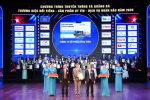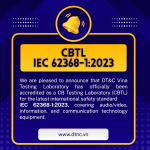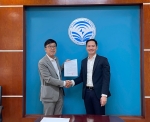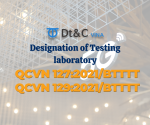(1) Certified CR for electrical safety, electromagnetic compatibility, bio-optics according to Regulation QCVN 19:2019/BKHCN of the Ministry of Science and Technology, details as follows:
→ Electrical safety part and EMI electromagnetic emission part: mandatory from 01/01/2021.
→ EMS electromagnetic immunity and photobiological safety: mandatory from 01/01/2023.
(Based on Decision No. 183/QD-BKHCN dated May 22, 2020 of the Ministry of Science and Technology, correcting QCVN 19:2019/BKHCN and the application roadmap of Circular No. 08/2019/TT - BKHCN)
(2) Testing and meeting the minimum energy efficiency requirements and announcing the energy label as prescribed in Decision 04/2017/QD-TTg and Circular 36/2016/TT-BCT of the Ministry of Industry and Trade (applicable to E27, B22 LEDs and G5, G13 LED tubes)
(3) Meet the requirements on the limit of toxic metal content (for LED bulbs) as prescribed by the Ministry of Industry and Trade in Circular No. 30/2011/TT-BCT
(4) LED lights used on vehicles (headlights) need to be certified according to regulations of the Ministry of Transport
(5) LED lights used for lighting works (LED traffic lights and urban lighting) and LED lights used for outdoor advertising purposes need certification of conformity according to regulations of the Ministry of Construction
According to the provisions of Decree 74/2018/ND-CP and Decision No. 3810/QD-BKHCN of the Ministry of Science and Technology, enterprises still have to carry out procedures for registration of state quality inspection for imported and exported LED lightings.
List of LED lights, LED bulbs, LED tubes required for certification of conformity (Refer to QCVN 19).
What are the codes, standards and regulations that apply to LEDs?
Decision No. 1383/QD-BKHCN adjusting the mandatory roadmap for application of LED lamp conformity certification.
Circular No. 08/2019/TT-BTTTT of the Ministry of Science and Technology.
National regulation QCVN 19:2019/BKHCN of the Ministry of Science and Technology.
TCVN 8782:2017 (IEC 62560:2015) – applicable to LED lamps.
TCVN 7722-1:2017 (IEC 60598-1:2014 with AMD1:2017): General requirements for LED luminaires.
TCVN 7722-2-x:2013 (IEC 60598-2-x): Particular requirements for each type of LED luminaires.
TCVN 11846:2017 (IEC 62776:2014): Requirements for double-ended LED tubes.
TCVN 7186:2018 (CISPR 15:2018): Requirements for electromagnetic compatibility - emission (mandatory to apply from 01/01/2021).
IEC 61547:2009 Ed 2.0: Electromagnetic compatibility requirements - immunity part (mandatory from 01/01/2023).
IEC 62471:2006: Bio-optical requirements (mandatory from 01/01/2023).
What are the processes, procedures, and documents required for LED lamp conformity certification?
Manufacturers and importers can certify LED lamps under certification method 1 (type test) with the following characteristics:
→ The certificate of conformity is valid for 3 years
→ Certificates are issued to domestic manufacturers or importers
→ Multiple product codes (models/types) can be listed on the same certificate
→ In some cases, foreign test results according to CB scheme may be accepted for conformity assessment.
→ The cost of certification depends on the number of models in the same application. The more product codes certified, the lower the unit price.
Documents required for LED lamp conformity certification under certification method 1 include:
(1) Application form for regulation conformity certification
(2) Product samples: 05 – 10 models / model depending on the type of LED
(3) Technical documentation of the product
(4) PCB schematic diagram and main components list
(5) Domestic or foreign test results (if any)
Testing and filing for conformity certification for LED lights:
Manufacturers and organizations and individuals importing can contact Dt&C Vina to perform testing services and authorize in charge of customs registration.
Pursuant to QCVN 19:2019/BKHCN, testing must be carried out at a designated laboratory (domestic laboratory), or recognized (CBTL laboratory). The laboratory's designated or accredited testing capacity and scope shall include the respective specifications applicable to the product.
Currently, Dt&C Vina is a CBTL-certified testing laboratory and has been designated as a testing laboratory with full capacity to test and provide test reports for LEDs.
Procedures for Announcement of Conformity
According to the provisions of Decree No. 74/2018/ND-CP and Circular No. 28/2012/TT-BKHCN, enterprises must carry out the procedures for announcing the technical-regulation conformity after the technical-regulation conformity certification process is completed. Procedures for declaration of conformity are carried out as follows:
For domestically produced goods: After being granted the certificate of conformity, the (domestic) manufacturer shall carry out procedures for declaration of conformity and submit a dossier at the local Sub-Department of Standards, Metrology, and Quality for registration. business registration. The competent authority will issue a notice of receipt of the announcement of regulation conformity.
For imported products and goods: Procedures for declaration of technical-regulation conformity are carried out through the state quality inspection registration process.
Energy Efficiency:
Pursuant to the Prime Minister's Decision No. 04/2017/QD-TTg - Regulation on the list of vehicles and equipment subject to energy labeling, the application of the minimum energy efficiency level and the implementation roadmap, the lights LEDs are required to reach the minimum energy efficiency level and label the energy after announcing the energy label to the competent authority of the Ministry of Industry and Trade from January 1, 2020.
In addition, LED lights must also have a certificate of electrical safety, electromagnetic compatibility and bio-optical compatibility according to QCVN 19:2019/BKHCN of the Ministry of Science and Technology. To learn more about certification of conformity according to QCVN 19:2019/BKHCN, please see our guide:
Pursuant to the applicable energy law for LED lights.
Decision No. 04/2017/QD-TTg of the Prime Minister - Regulating the list of vehicles and equipment subject to energy labeling, application of minimum energy efficiency levels and implementation roadmap.
Circular No. 36/2016/TT-BCT of the Ministry of Industry and Trade - Regulations on energy labeling for vehicles and equipment managed by the Ministry of Industry and Trade.
Decision No. 4889/QD-BCT dated December 27, 2018 of the Ministry of Industry and Trade - Announcement of technical standards and guidelines for announcing efficiency and energy labeling for LED lights
TCVN 11843:2017 - LED lamps, LED luminaires, and LED modules - Test methods
TCVN 11844:2017 - LEDs - Energy efficiency
Based on the scope of application of TCVN 11844:2017 and the guidance in Decision No. 4889/QD-BCT dated December 27, 2018 of the Ministry of Industry and Trade, it is only mandatory to apply the minimum energy efficiency and label the energy. energy for LEDs with built-in ballasts with E27 and B22 caps and G5 and G13 double-ended LED bulbs in the new phase of energy efficiency application for LEDs.
Required documents for Energy Label Publication for LEDs:
- Form of Declaration of Energy Labeling
- Energy efficiency test results
- Documents proving that the foreign laboratory is qualified if the test results are provided by the foreign laboratory
- Sample of the proposed energy label
* Notes on performing testing and Publishing Energy Labels for LEDs:
(1) LEDs must have a minimum claimed life of 12,000 hours
(2) The manufacturer or distributor must declare the warranty period
(3) The same product code/series but with different color temperature must test and publish the energy label for each color temperature








![[MIC] Officially issued QCVN 134:2024/BTTTT - National technical regulation on specific absorption levels for handheld and body-worn radio devices according to Circular 19/2024/TT-BTTTT of Ministry of Information and Communications](https://cdn0577.cdn4s.com/thumbs/qcvn-134_thumb_150.jpg)



![[Latest] Circular 02/2024/TT-BTTTT regulating the List of potentially unsafe products and goods under the management responsibility of the Ministry of Information and Communications](https://cdn0577.cdn4s.com/thumbs/trang-huy-hieu-the-loai-logo-2_thumb_150.jpg)
